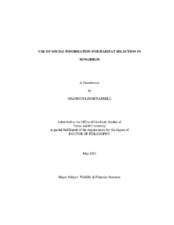| dc.contributor.advisor | Morrison, Michael L. | |
| dc.creator | Farrell, Shannon Leigh | |
| dc.date.accessioned | 2012-07-16T15:57:19Z | |
| dc.date.accessioned | 2012-07-16T20:17:35Z | |
| dc.date.available | 2012-07-16T15:57:19Z | |
| dc.date.available | 2012-07-16T20:17:35Z | |
| dc.date.created | 2011-05 | |
| dc.date.issued | 2012-07-16 | |
| dc.date.submitted | May 2011 | |
| dc.identifier.uri | https://hdl.handle.net/1969.1/ETD-TAMU-2011-05-9458 | |
| dc.description.abstract | Habitat selection research has focused on the role of vegetative and geologic habitat characteristics or antagonistic behavioral interactions. Conspecifics can confer information about habitat quality and provide positive density-dependent effects that may result in improved fitness, resulting in positive behavioral responses to conspecifics as a habitat selection strategy. I conducted 3 replicated, manipulative experiments to investigate use of conspecific cues in habitat selection for the golden-cheeked warbler (Dendroica chrysoparia) using simulated conspecific vocalizations during pre-settlement and post-breeding periods, across a range of woodland canopy cover. I measured territory density, pairing, and fledging success in paired treatment and control units. Territory density was >2 times higher in treatment units across the range of canopy (P = 0.02). Pairing success was positively correlated with territory density (P = 0.008). Territory density response was higher for pre-settlement than post-breeding treatment (P = 0.004). I found pre-settlement and post-breeding conspecific cues influence golden-cheeked warbler habitat selection, inducing settlement in previously unoccupied areas, and producing aggregations within areas of similar vegetative characteristics. Better understanding of social information use in habitat selection can improve our understanding of species distributions, yielding more accurate predictive distribution models; improve our ability to predict impacts of habitat changes on habitat use, survival, reproduction, and ultimately fitness; and provide a potential tool for attracting individuals to restored or managed sites. | en |
| dc.format.mimetype | application/pdf | |
| dc.language.iso | en_US | |
| dc.subject | avian ecology | en |
| dc.subject | passerines | en |
| dc.subject | endangered species | en |
| dc.subject | habitat selection | en |
| dc.subject | social information | en |
| dc.subject | competition | en |
| dc.subject | density-dependence | en |
| dc.title | Use of social information for habitat selection in songbirds | en |
| dc.type | Thesis | en |
| thesis.degree.department | Wildlife and Fisheries Sciences | en |
| thesis.degree.discipline | Wildlife and Fisheries Sciences | en |
| thesis.degree.grantor | Texas A&M University | en |
| thesis.degree.name | Doctor of Philosophy | en |
| thesis.degree.level | Doctoral | en |
| dc.contributor.committeeMember | Cathey, James | |
| dc.contributor.committeeMember | Packard, Jane | |
| dc.contributor.committeeMember | Rosenthal, Gil | |
| dc.type.genre | thesis | en |
| dc.type.material | text | en |


